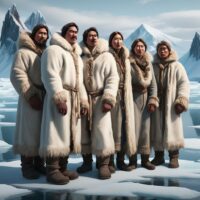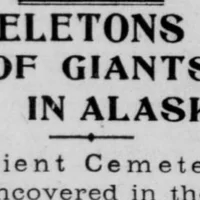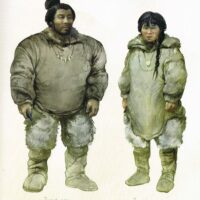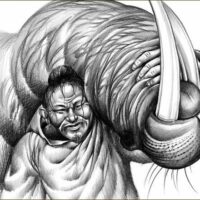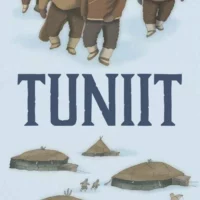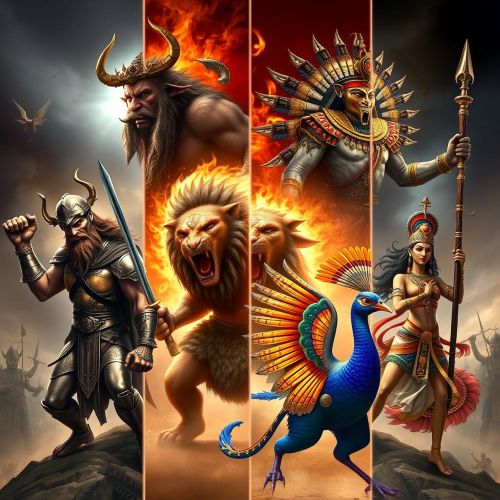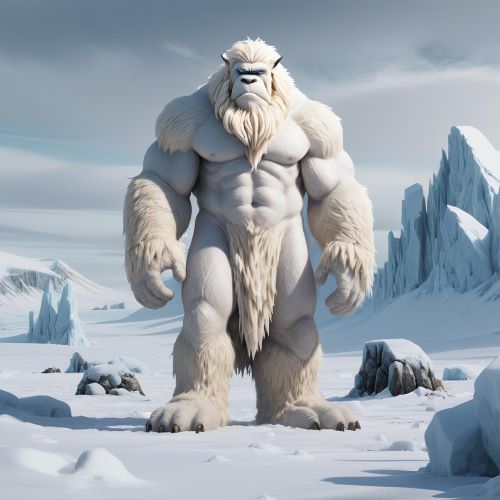Tuniit : The Shy Giants
Listen
At a glance
| Description | |
|---|---|
| Origin | Inuit Mythology |
| Classification | Mortals |
| Family Members | N/A |
| Region | Greenland, Canada, Alaska |
| Associated With | Super Strength, SIze |
Tuniit
Introduction
In the intricate fabric of Inuit mythology, the Tuniit emerge as enigmatic and formidable entities. Often depicted as giants or powerful beings, they hold a significant role in the folklore and oral traditions of Arctic peoples, embodying a mysterious and revered presence. Within the vast and unforgiving Arctic landscape, Inuit mythology recounts the existence of the Tuniit, an ancient race that once traversed the frozen plains. These beings occupy a unique niche in Inuit lore, blurring the boundaries between myth and reality. Referred to as the Tornit or Tuniq in some accounts, the Tuniit are legendary figures from Inuit mythology, believed to be the original inhabitants of the Arctic regions, preceding the Inuit. Descriptions portray them as peaceful individuals who lived in harmony with nature, speaking a simple language known as “Kutak” or “baby-talk.”
Physical Traits
Physically, the Tuniit were described as thick-bodied individuals with remarkable strength, distinguishing them as formidable figures in Inuit legends. They were often portrayed as towering over ordinary humans, with some stories depicting them as giants. Legends recount impressive feats of strength, such as one Tuniit man carrying a seal weighing over 500 kilograms—a task considered beyond human capability. Despite their imposing stature and physical prowess, the Tuniit were characterized by shyness and timidity, often depicted as easily frightened and reclusive.
Inuit lore describes the Tuniit as robust and powerful beings capable of navigating the harsh Arctic environment with ease. Their appearance is often associated with strength and endurance, with tales suggesting their skin was as hard as stone or ice. Despite their formidable presence, details about their facial features remain ambiguous, allowing storytellers to interpret their visage creatively.
The juxtaposition of the Tuniit’s physical prowess and shy demeanor has led to speculation about their true nature. Some interpretations suggest that their giant-like stature could have been misunderstood by the arriving Inuit due to cultural and language differences. This perspective challenges the literal interpretation of their legendary status, proposing a nuanced understanding of the Tuniit as a unique and enigmatic people within Inuit mythology.
Family
The Tuniit, within Inuit mythology, are often portrayed as a collective group or race rather than individual families, reflecting a strong sense of kinship and communal living. Legends depict them as the original inhabitants of the Arctic regions before the arrival of the Inuit, suggesting a deep ancestral connection. The nature of their relationship with other mythical figures like Sedna varies across narratives, with some stories hinting at a familial bond, portraying the Tuniit as ancestors or distant relatives of the Inuit.
Inuit stories provide little insight into the detailed social structure of the Tuniit. Legends suggest they lived in small, scattered settlements across the Arctic, raising questions about their family dynamics and societal organization. The specifics of Tuniit family life and community structure remain unresolved mysteries within Inuit mythology.
A notable aspect of the Tuniit is their language, described in legends as a simple tongue known as “Kutak” or “baby-talk.” This linguistic detail invites various interpretations—it may reflect a simpler societal structure, a communication barrier with the Inuit, or symbolize the perceived innocence and timidity associated with the Tuniit in folklore. The nuances of Tuniit culture, including their social interactions and language, contribute to the enigmatic allure surrounding these ancient beings in Inuit mythology.
Other names
The legendary race known as the Tuniit is not solely referred to by that name within Inuit mythology; they are also known as “Tornit” and “Tuniq” in various myths. These alternative names reflect the diverse oral traditions and dialects across different Inuit communities scattered across the Arctic regions. The term “Tuniit” is just one of many monikers associated with these mysterious beings. Different Inuit groups have their own variations, with some referring to them as “Saqqaqtang,” “Tornit,” or “Siqirnuit.” These variations highlight the regional interpretations of the Tuniit legend.
Furthermore, the Tuniit are also known by the name “Sivullirmiut” in certain Inuit communities, which encompasses the concept of ancient beings or early inhabitants. These alternative names emphasize the diverse interpretations and localized nuances of Inuit mythology, showcasing the fluidity and adaptability inherent in oral traditions. The varying names attached to the Tuniit illustrate how this legendary race is understood and depicted across different Arctic regions within Inuit folklore.
Powers and Abilities
Legends surrounding the Tuniit highlight their formidable physical attributes, often portraying them as possessing a unique connection to the natural world, possibly hinting at rudimentary shamanistic practices or advanced hunting techniques. However, it’s important to view these narratives through the lens of oral tradition, which likely includes embellishments over time. The reality of the Tuniit’s abilities likely reflects practical skills developed through adaptation to the challenging Arctic environment.
The Tuniit were renowned for their exceptional strength, surpassing that of the Inuit, and they were skilled hunters and gatherers, adept at thriving in harsh Arctic conditions. Unlike some mythical figures in Inuit lore, the Tuniit were not typically associated with supernatural powers. While some stories attribute them with control over natural elements like ice and wildlife, including shape-shifting abilities, these depictions symbolize a deep spiritual connection to the Arctic landscape rather than literal supernatural powers. Their portrayal underscores a profound symbiosis with nature, reflecting their intimate relationship with the environment.
Modern Day Influence
The legacy of the Tuniit continues to resonate within and beyond Inuit communities in contemporary times. Their mythical presence fosters cultural pride and inspiration, nurturing a deeper appreciation for indigenous traditions and storytelling. Artists and writers draw from Tuniit mythology as a creative wellspring, infusing modern interpretations with ancient motifs and symbolism. The resilience and strength embodied by the Tuniit offer valuable lessons for addressing contemporary challenges, echoing the enduring spirit of Arctic cultures.
Moreover, the Tuniit remain influential in modern Inuit culture. Their stories are transmitted across generations, enriching cultural heritage and identity. References to the Tuniit are common in Inuit art, literature, and storytelling, symbolizing the deep roots and enduring resilience of Arctic peoples. Tuniit mythology provides a unique perspective on the profound connection between the Inuit and their environment, offering timeless lessons on survival, nature respect, and community bonds.
The Tuniit legend holds a significant place in the modern Inuit world, serving as a testament to the land’s long history and the existence of earlier inhabitants. Intriguingly, archaeological findings suggest the presence of a pre-Inuit culture in the Arctic—the Dorset culture, which thrived for millennia before the arrival of the Inuit. The Dorset people, adept at adapting to the harsh Arctic environment, left behind sophisticated tools and dwellings resembling those described in Tuniit tales. While not definitive proof, the timeline of the Dorset culture coincides with the disappearance of the Tuniit in Inuit mythology, establishing a fascinating connection.
Furthermore, DNA analysis of ancient remains supports this link, revealing ancestral ties between the Dorset culture and modern-day Inuit populations. This suggests potential interaction or interbreeding between the two groups, lending credibility to the notion that Tuniit legends may be rooted in encounters with a real past civilization.
The Tuniit represent more than myth—they embody a bridge between the past and present, highlighting the dynamic history of the Arctic. Their enigmatic presence underscores the enduring power of oral traditions and the human quest to explain the unknown. Whether the Tuniit were actual giants or misunderstood neighbors, their legacy endures in the whispered stories across Arctic landscapes, reminding us of the mysteries waiting to be uncovered.
Related Images
Frequently Asked Questions
What is lorem Ipsum?
I am text block. Click edit button to change this text. Lorem ipsum dolor sit amet, consectetur adipiscing elit. Ut elit tellus, luctus nec ullamcorper mattis, pulvinar dapibus leo.
What is lorem Ipsum?
I am text block. Click edit button to change this text. Lorem ipsum dolor sit amet, consectetur adipiscing elit. Ut elit tellus, luctus nec ullamcorper mattis, pulvinar dapibus leo.
What is lorem Ipsum?
I am text block. Click edit button to change this text. Lorem ipsum dolor sit amet, consectetur adipiscing elit. Ut elit tellus, luctus nec ullamcorper mattis, pulvinar dapibus leo.
What is lorem Ipsum?
I am text block. Click edit button to change this text. Lorem ipsum dolor sit amet, consectetur adipiscing elit. Ut elit tellus, luctus nec ullamcorper mattis, pulvinar dapibus leo.
What is lorem Ipsum?
I am text block. Click edit button to change this text. Lorem ipsum dolor sit amet, consectetur adipiscing elit. Ut elit tellus, luctus nec ullamcorper mattis, pulvinar dapibus leo.

